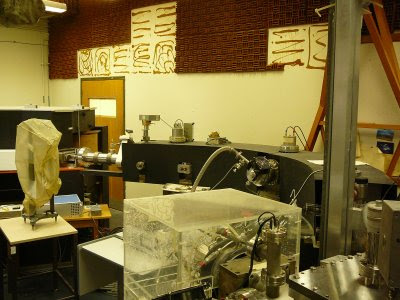Australian science history and culture
One of the more impressive accomplishments of Australian geoanalytical science is the invention of the SHRIMP mass spectrometer.
The SHRIMP, or Sensitive High Resolution Ion MicroProbe, is the first instrument that can directly determine the age of a mineral in situ; before SHRIMP, the only way to measure radiogenic ages was to dissolve the target mineral, chemically separate the parent and daughter products, and measure them independently.
Back when the SHRIMP was first built, in the early 80’s, it was very loud. The SHRIMP avoids chemical interferences in its lead measurements by achieving mass resolution so high that the binding energy of the nuclei separates lead from molecules with the same nominal mass. It does this by having a very large radius magnet. This, in turn, results in a large instrument, which has a large volume, all of which needs to be kept under vacuum. The high vacuum is maintained with turbo pumps. Modern turbo pumps are barely noticeable, but the early ones used in the 80’s were very loud.
Also, the SHRIMP was built in a room directly under the library. As a result, it was sound-proofed, as is shown below.
Figure 1. The SHRIMP lab, with aging sound-proof tiles.
Technological advancements mean that this soundproofing has become superfluous as the pumps have become quieter. As a result, it is not maintained. 30 years of vacuum oil have slowly colored the white foam tiles brown, and the foam has begun to fall apart. As the foam is less durable than the glue that was used to hold it to the walls and ceiling, when the tiles eventually come off, they leave glue marks where they were attached (fig 1.).
This is interesting, because by analyzing these gluemarks, we can deduce that the people who installed these tiles grew weary of the task during installation. Before proceeding, however, you need to realize that this is the crown jewel of Australian geoanalytical science. For 10 years, it was the only machine in the world that could do what it does, and it revolutionized the study of complex, multiply metamorphosed terrains that make up the bulk of the early earth rock record. Scientists from all over the world come to see it. Which is what makes the following all the more amusing.
Figure 2. Geochronology allows us to decode messages from the past.
In a tightwad culture, this would be a scandal; a disgrace. Here, though, it’s revered history. Australian for classy.


1 comment:
Wow. Gawd bless you, Australia!!
Post a Comment